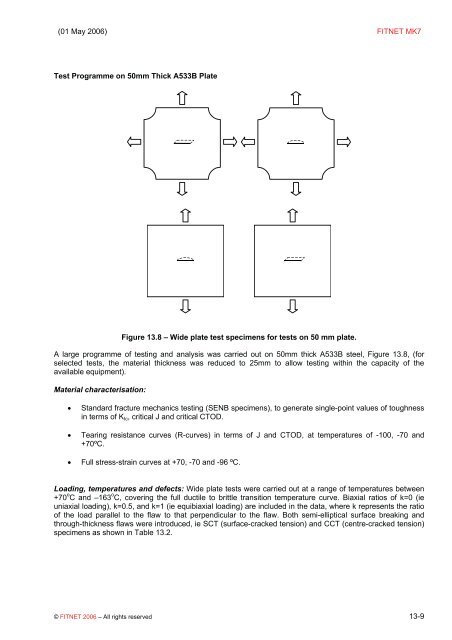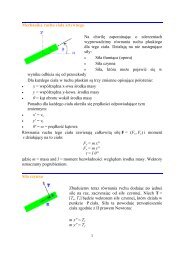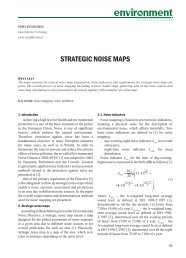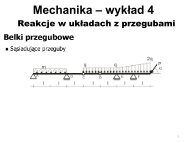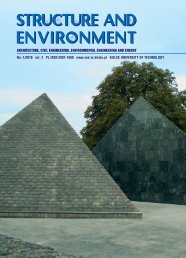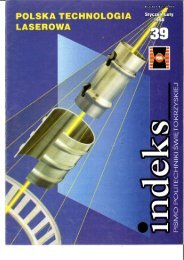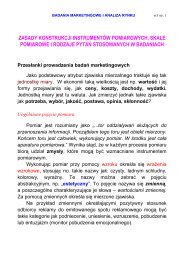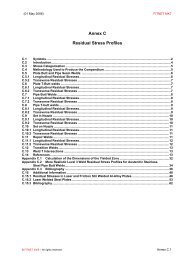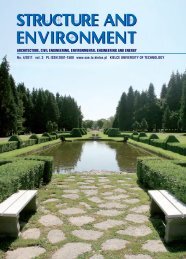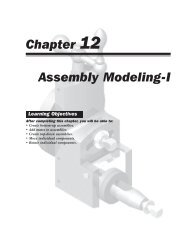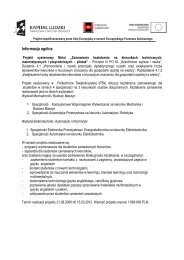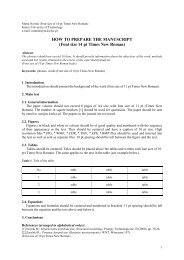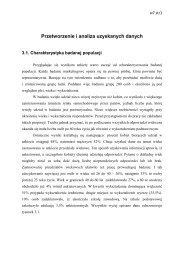- Page 1: FITNET FFS MK7- Section 13VALIDATIO
- Page 4 and 5: FITNET FFS - MK7- Section 1313.1 In
- Page 6 and 7: FITNET FFS - MK7- Section 13Figure
- Page 8 and 9: FITNET FFS - MK7- Section 13Figure
- Page 12 and 13: FITNET FFS - MK7- Section 13Table 1
- Page 14 and 15: FITNET FFS - MK7- Section 134.03.53
- Page 16 and 17: FITNET FFS - MK7- Section 134.03.53
- Page 18 and 19: FITNET FFS - MK7- Section 1390-110m
- Page 20 and 21: FITNET FFS - MK7- Section 134.03.53
- Page 22 and 23: FITNET FFS - MK7- Section 13The pla
- Page 24 and 25: FITNET FFS - MK7- Section 13Table 1
- Page 26 and 27: FITNET FFS - MK7- Section 134.03.5o
- Page 28 and 29: FITNET FFS - MK7- Section 13Primary
- Page 30 and 31: FITNET FFS - MK7- Section 13There w
- Page 32 and 33: FITNET FFS - MK7- Section 133 FAD S
- Page 34 and 35: FITNET FFS - MK7- Section 13For L r
- Page 36 and 37: FITNET FFS - MK7- Section 13Residua
- Page 38 and 39: FITNET FFS - MK7- Section 1313.2.6
- Page 40 and 41: FITNET FFS - MK7- Section 13plotted
- Page 42 and 43: FITNET FFS - MK7- Section 13Assessm
- Page 44 and 45: FITNET FFS - MK7- Section 131.1 TES
- Page 46 and 47: FITNET FFS - MK7- Section 13plate e
- Page 48 and 49: FITNET FFS - MK7- Section 1313.2.7
- Page 50 and 51: FITNET FFS - MK7- Section 13Table 1
- Page 52 and 53: FITNET FFS - MK7- Section 13[13.15]
- Page 54 and 55: FITNET FFS - MK7- Section 13300250r
- Page 56 and 57: FITNET FFS - MK7- Section 1313.2.8
- Page 58 and 59: FITNET FFS - MK7- Section 13Table 1
- Page 60 and 61:
FITNET FFS - MK7- Section 1313.2.9
- Page 62 and 63:
FITNET FFS - MK7- Section 13The 28J
- Page 64 and 65:
FITNET FFS - MK7- Section 13Pf⎪
- Page 66 and 67:
FITNET FFS - MK7- Section 1313.2.10
- Page 68 and 69:
FITNET FFS - MK7- Section 13steel p
- Page 70 and 71:
FITNET FFS - MK7- Section 13factor
- Page 72 and 73:
FITNET FFS - MK7- Section 1313.2.11
- Page 74 and 75:
FITNET FFS - MK7- Section 13Figure
- Page 76 and 77:
FITNET FFS - MK7- Section 13Figure
- Page 78 and 79:
FITNET FFS - MK7- Section 13Table 1
- Page 80 and 81:
FITNET FFS - MK7- Section 13Table 1
- Page 82 and 83:
FITNET FFS - MK7- Section 1313.3 Ca
- Page 84 and 85:
FITNET FFS - MK7- Section 13Table 1
- Page 86 and 87:
FITNET FFS - MK7- Section 130.88 54
- Page 88 and 89:
FITNET FFS - MK7- Section 13Analysi
- Page 90 and 91:
FITNET FFS - MK7- Section 13Individ
- Page 92 and 93:
FITNET FFS - MK7- Section 13Table 1
- Page 94 and 95:
FITNET FFS - MK7- Section 13Signifi
- Page 96 and 97:
FITNET FFS - MK7- Section 1313.3.4
- Page 98 and 99:
FITNET FFS - MK7- Section 13The equ
- Page 100 and 101:
FITNET FFS - MK7- Section 1313.3.5
- Page 102 and 103:
FITNET FFS - MK7- Section 13Figure
- Page 104 and 105:
FITNET FFS - MK7- Section 13Case 2:
- Page 106 and 107:
FITNET FFS - MK7- Section 13Based o
- Page 108 and 109:
FITNET FFS - MK7- Section 13P= 1.15
- Page 110 and 111:
FITNET FFS - MK7- Section 13ThusC*=
- Page 112 and 113:
FITNET FFS - MK7- Section 13Creep R
- Page 114 and 115:
FITNET FFS - MK7- Section 13σ refa
- Page 116 and 117:
FITNET FFS - MK7- Section 13• In
- Page 118 and 119:
FITNET FFS - MK7- Section 13tCD = 4
- Page 120 and 121:
FITNET FFS - MK7- Section 13Where x
- Page 122 and 123:
FITNET FFS - MK7- Section 132000.0
- Page 124 and 125:
FITNET FFS - MK7- Section 132000.0
- Page 126 and 127:
FITNET FFS - MK7- Section 13Figure
- Page 128 and 129:
FITNET FFS - MK7- Section 13where
- Page 130 and 131:
FITNET FFS - MK7- Section 13K = (F
- Page 132 and 133:
FITNET FFS - MK7- Section 13A8.6.4.
- Page 134 and 135:
FITNET FFS - MK7- Section 13Table A
- Page 136 and 137:
FITNET FFS - MK7- Section 13Stress(
- Page 138 and 139:
FITNET FFS - MK7- Section 133002502
- Page 140 and 141:
FITNET FFS - MK7- Section 13Figure
- Page 142 and 143:
FITNET FFS - MK7- Section 13From R5
- Page 144 and 145:
FITNET FFS - MK7- Section 13σb3Pl=
- Page 146 and 147:
FITNET FFS - MK7- Section 13Since t
- Page 148 and 149:
FITNET FFS - MK7- Section 13Cycle 2
- Page 150 and 151:
FITNET FFS - MK7- Section 13sif(r.m
- Page 152 and 153:
FITNET FFS - MK7- Section 132nd cra
- Page 154 and 155:
FITNET FFS - MK7- Section 13B. Fati
- Page 156 and 157:
FITNET FFS - MK7- Section 13B2. Fat
- Page 158 and 159:
FITNET FFS - MK7- Section 13D. Stre
- Page 160 and 161:
FITNET FFS - MK7- Section 13D2. Str
- Page 162 and 163:
FITNET FFS - MK7- Section 13E. Stra
- Page 164 and 165:
FITNET FFS - MK7- Section 13t = 24.
- Page 166 and 167:
FITNET FFS - MK7- Section 13151413E
- Page 168 and 169:
FITNET FFS - MK7- Section 13withdtD
- Page 170 and 171:
FITNET FFS - MK7- Section 1313.5.2
- Page 172:
FITNET FFS - MK7- Section 13failure


